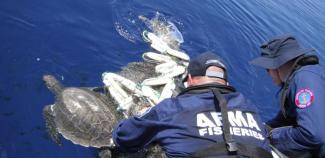
AFMA has a long history of working with the fishing industry, indigenous stakeholders, and partners in the fight against marine debris, particularly around ghost nets.
What are ghost nets?
Ghost nets are abandoned, lost or otherwise discarded fishing gear (ALDFG) in the marine environment and are a global problem.
As ghost nets drift around the world, picked up by global currents and tides they continue to indiscriminately ‘fish’ impacting threatened and endangered species. Ghost nets can result in significant environmental damage, introduce marine pests and synthetic materials and create safety hazards impacting shipping or navigation.
Collectively ghost nets and other discarded fishing gear are referred to internationally as Abandoned, Lost, Discarded Fishing Gear (ALDFG). The threats posed by ALDFG are enduring and, without intervention, can continue to cause a wide variety of issues within the marine environment.In Australia, the vast majority of ghost nets are found across northern Australia, causing issues for many of the remote communities.
Australian government response to ghost nets
The Department of Climate Change, Energy, the Environment and Water is the government agency responsible for managing harmful marine debris including ghost nets in Australian waters. The Australian Maritime Safety Authority also has legislative responsibility for marine pollution and providing safe navigation. States and Territories have complementary frameworks.
Find more information on Australia’s Ghost Net Initiative on the Parks Australia website.
While legislative responsibility for the Commonwealth sits within those two portfolios, responses are affected through a whole of government approach, drawing on the strengths of various agencies to deliver an effective outcome.
Australian Government agencies also partner with non-government organisations that contribute significant resources and support. Responses include on-the-water recovery, beach clean-ups, dedicated disposal facilities, as well as targeting the problem at its source.
Collaboration across government and non-government entities has ensured that the response is comprehensive and targets the highest risk areas.
What does AFMA do?
AFMA works with partner agencies such as the Department of Climate Change, Energy, the Environment and Water, Maritime Border Command (MBC) within the Australian Border Force (ABF), and Parks Australia as well as the recreational and commercial fishing industry to identify and retrieve ALDFG.
For every retrieval, AFMA collects relevant data, including location, date, type of fishing gear and the catch composition. This data shows that the majority of ALDFG are found across Australia’s northern waters from Broome to the Torres Strait. Based on the type of net and its location, in most cases the nets and fishing gear retrieved have been lost or abandoned in waters outside Australian jurisdiction in countries to the north of Australia and have subsequently drifted into the Australia Fishing Zone. We know this because they are of a configuration which are not used by Australian fishers operating in Commonwealth waters managed by AFMA
AFMA’s contribution to efforts to detect and respond to marine threats in Australian waters help to ensure that Australia’s fisheries resources remain sustainable and the marine environment healthy for years to come.
Retrieving ghost nets
The sighting, retrieval and disposal of ALDFG found in Australian waters requires a whole-of-government approach.
When AFMA receives a report of ALDFG, we work with MBC and Parks Australia to review options for the retrieval of the abandoned fishing net. The retrieval may involve government assets or a contracted vessel who is tasked to recover the ghost net, remove any marine life and deliver the ghost net to a disposal facility. Recovered fishing gear can pose a biosecurity risk and such gear needs to be handled and disposed of appropriately.
Where location and circumstances allow, recovered ghost nets have been delivered to remote communities where they have been reused and repurposed into artworks by local and indigenous communities. AFMA has commissioned several ghost net artworks from Erub Arts, Pormpuraaw Art & Culture Centre and Gapuwiyak Culture and Arts Centre.
Tracking ghost nets
When a ghost net retrieval is not practicable, GPS tracking devices can be attached enabling the net to be monitored.
GPS tracking enhances our ability to continually track the nets while they are drifting and arrange for their immediate retrieval by an appropriate vessel.
The use of GPS tracking devices also provides valuable information relating to the movement of ghost nets in Australian and adjacent waters.
How you can help
AFMA and its partner agencies are committed to protecting Australia’s biodiversity and resources. The Australian public is also a valuable partner in helping AFMA to identify maritime threats.
If you encounter a ghost net or other source of ALDFG you can report it to AFMA on 02 6275 5818.